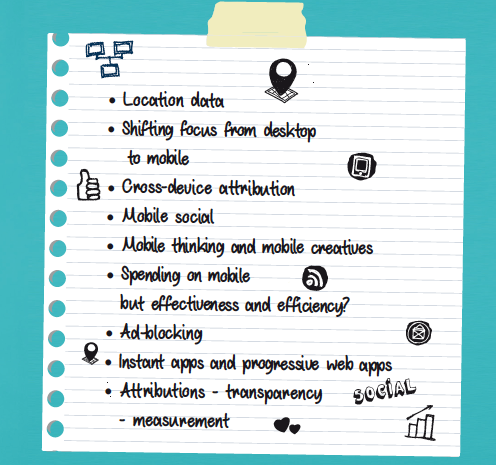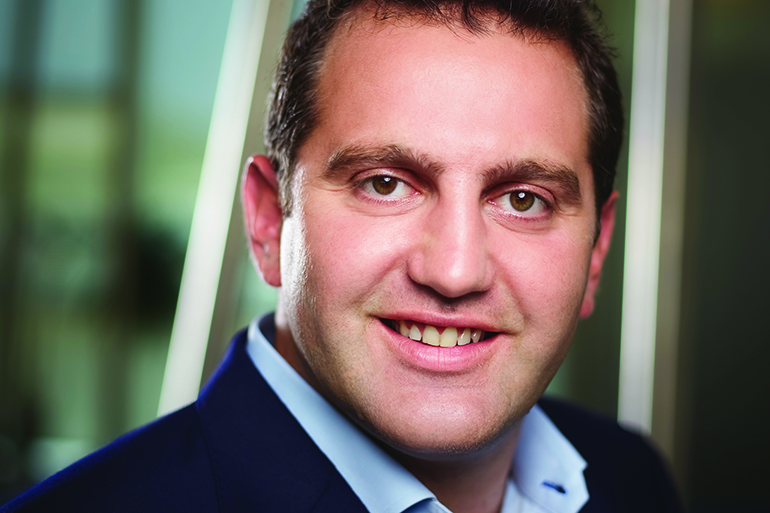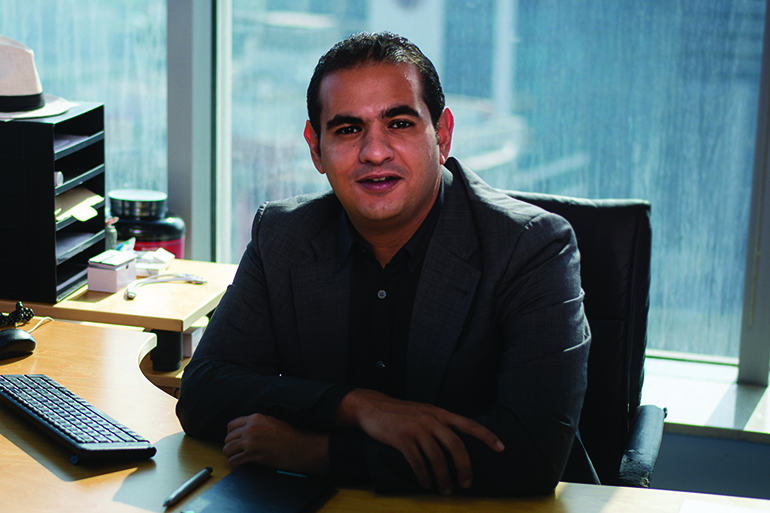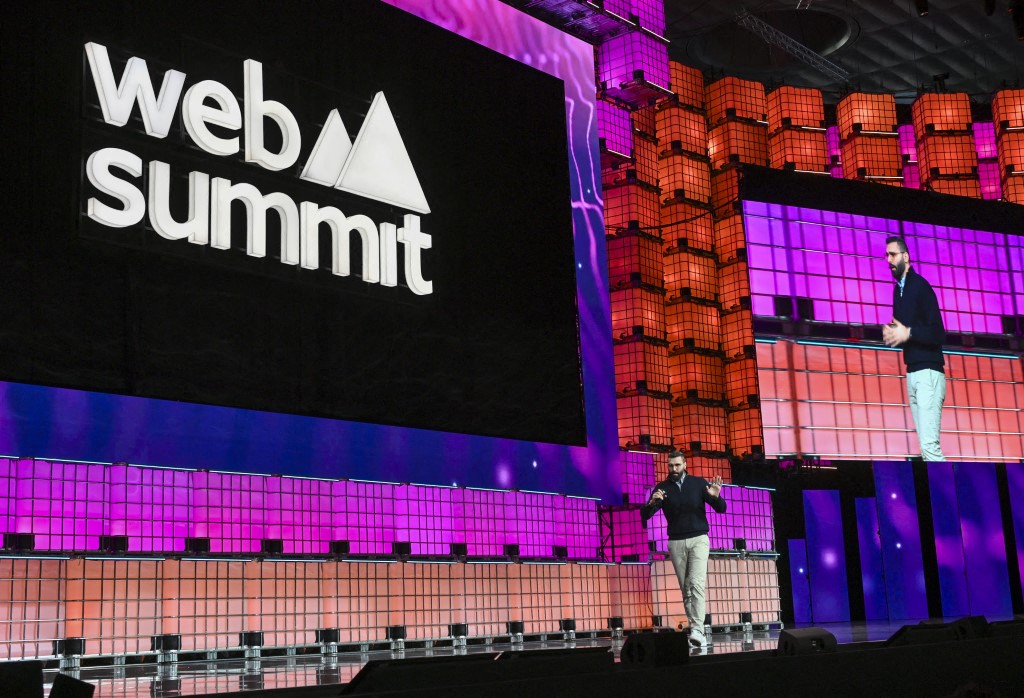These were some of the thoughts that came out of the agencies’ feedback on what our mobile story should be on. Clearly, they couldn’t agree on one thing so we decided to let them talk about whatever they wanted to talk about. Over to the experts…

Fahad Maghrabi, digital director, Initiative Riyadh

What are the opportunities/technologies that you’re excited about in mobile advertising?
Mobile revolutionized how we plan campaigns. It offers a wide range of tactics and formats that enable more targeted advertising, yielding greater results. Beacon technology is one aspect I’m excited about. It allows Bluetooth devices to broadcast and/or receive tiny and static pieces of data within short distances, for optimal advertising campaigns.
What’s the one (or more) thing(s) everyone should stop talking about with regard to mobile advertising?
Standard mobile banners – it should be stopped completely. Mobile ads should be utilized in ways that deliver better results and performance by applying different formats, such as video or interactive ads and, more importantly, native ads, which are leading in terms of performance.
Mind and money: is mobile at the center of the strategy or is it an afterthought? How are budgets reflecting this thinking (or lack of it)?
It is certainly at the center. Mobile takes the lion’s share of most of our clients’ digital budgets. After clients witnessed the great results delivered through mobile ads, they amended their strategies and budgets to put mobile at the epicenter.
Where’s the biggest education gap – if there is one – for clients?
Clients these days are very knowledgeable and most of them come from a digital marketing background. The advertising industry is evolving fast and the challenge for all is to remain ahead of the curve to be able to assess what works best for their particular industry.
What’s the best and worst ‘mobile’ campaign you’ve seen and why?
Best: Mate 8 launch for Huawei. That was some great utilization of mobile advertising. The ads would appear to mobile users when their battery is low, informing them about Mate 8 smartpower technology. By connecting our campaign to mobile
technologies, we transmitted different relevant messages at various battery life levels and also when the phone was plugged into the charger.
Worst: I am not specifying here, but running a campaign on mobile that directs users to a non-responsive landing page or micro-site.
The most ridiculous client ask pertaining to mobile?
“I want to run a mobile campaign and send SMSes to my customer base!”
Nadim Khouri, head of content and experiences, OMD UAE

What are the opportunities/technologies that you’re excited about in mobile advertising?
- The emergence of location targeting at scale, as we can unlock greater opportunities to bridge the online/offline gap and, more importantly, assist with real-world interactions.
- More accuracy and better ways to verify location allows engagement rates to drive brands and business forward, faster and stronger than ever before. In addition, creating segments based on where someone has already been allows for smarter targeting across the consumer’s daily journey, be it over the mobile network or wi-fi zones.
- Bots and promoted ‘live’ social media opportunities. Bots within mobile ads are a neat way to promote specific products or services. With live social media opportunities, the challenge was limited reach, but now the equation has changed, as they can be promoted on Twitter and Facebook.
- Snapchat has launched and features a set of new and innovative opportunities (Lenses, geo-filters, snap ads) within the platform that feel very organic.
- The rise of messaging apps is already representing a bigger share of absolute time spent and it will continue to increase in the immediate future, as the apps evolve into full-fledged marketing platforms, enabling commerce/transactional behavior.
What’s the one (or more) thing(s) everyone should stop talking about with regard to mobile advertising?
Dare I say, “This is the year of mobile!”
Mobile advertising cannot be treated in isolation, but rather should be a key ingredient in the overall brand communication. While some great opportunities are mobile-only, a large amount of mobile investment is derived from social media advertising, where almost 95 percent of it is consumed on mobile and ad types offered are optimized for mobile as a main priority.
Mind and money: is mobile at the center of the strategy or is it an afterthought? How are budgets reflecting this thinking (or lack of it)?
Mobile-first will become the norm – especially given that the majority of digital investments are around organic/paid social, mobile de facto gets the lions’ share and has been enjoying this pendulum switch for the past year or so. More so as mobile video dominates social [media] and mobile programmatic takes an upward trajectory.
Where’s the biggest education gap – if there is one – for clients?
While clients have come a long way, the challenges that do remain are:
- Investment remains low in the adoption of mobile-only products, not allowing brands to benefit from the growing possibilities made available. As mobile players, ad formats and buying models keep evolving, the space is getting somewhat more confusing and hence staying up-to-date is difficult.
- Mobile must be treated more holistically outside of the app environment, in light of its role to drive footfall and sales for the traditional click-and-mortar retailers.
What’s the best and worst ‘mobile’ campaign you’ve seen and why?
Best: From a creative perspective, the most interesting mobile ads are the ones that think about leveraging the functionality of the phone in a creative way. These would include the gyroscope, sound, vibration and, more recently, the microphone and home button. For example, blowing into the phone microphone to clear the rubble from the screen or [finding out] one’s temperature by touching the home button are just a few recent evolutions made possible.
From a targeting perspective, the best ads are the ones that think of a clever way to leverage location – and competitors’ locations – and build segments over time and plan smartly when the ads should be pushed to the users.
Worst: Where the [client] ask is to communicate for a very short duration with very limited budgets. A two-day campaign that is heavily geo-fenced results in limited impressions, with no time to build momentum or optimize between the network of apps used. This most often results in poor conversions and hence is unsuccessful.
The most ridiculous client ask pertaining to mobile?
- “I want to reach everyone in the UAE with a mobile device. Possible?”
- “My client is showing up at the location
that is being geo-fenced, can you make sure that the ad is viewed on his device when he gets there?”
Ricardo Perez Campo, digital lead, Coca-Cola, UM MENA

What are the opportunities/technologies that you’re excited about in mobile advertising?
The mobile landscape in MENA today reaches more than 300 million unique subscribers, becoming the main delivery channel for marketing communications. The proximity that mobile devices have compared to almost every other media touchpoint is what marketers try to leverage to create contextually relevant experiences. The real opportunity lies at the heart of what the mobile technology offers in terms of digital experiences. To that point, I believe AR and VR applications are picking up, as marketers experiment with ways to utilize these for a branded experience. However, the fuel for these technologies is the current rapid advancement in Artificial Intelligence, which is what eventually will immerse the user in a completely life-life digital realm.
What’s the one (or more) thing(s) everyone should stop talking about with regard to mobile advertising?
After finally getting over “the year of mobile” that lingered for some five years now, I believe there are several misconceptions or outdated terms, such as ‘mobile friendly’ that often refers to a site that can function on mobile. Firstly, any thinking of that sort implies we are still relying on traditional displays that became outdated several years ago. Moreover, designs today are “responsive” in nature, which means they dynamically adjust to the many screen types that exist among consumers.
Another buzzword that people should stop using and applying is ‘premium’, which in digital inventory terms has not been clearly defined, and potentially does not exist, but is often used to classify more ‘expensive’ placements.
Mind and money: is mobile at the center of the strategy or is it an afterthought? How are budgets reflecting this thinking (or lack of it)?
This goes back to the unfortunate rush to commercialize inventory by vendors and a lack of understanding of the digital space by advertisers. The way strategies are thought of relies on inputs such as consumer behavior, market dynamics and other factors, to set up a platform for marketing communication. This should define the space where the consumer is reachable, which means mobile, as a device simply becomes one of the delivery channels or touchpoints. What we often fail to notice, is that this device is NOT the final channel and what users are experiencing on these devices is what matters – whether they are simply browsing social media or playing an advanced MORPG.
Where’s the biggest education gap – if there is one – for clients?
The use of programmatic, just like mobile in a way, is still being confused or treated as a channel on its own, when again it is what the user is going through that matters. There needs to be a deeper understanding of these as “tools” and what we trigger within those tools is what matters. The targeting parameters we apply on programmatic, the methods of buying and the audiences we generate is what we should be focused on. Yet, sometimes, it is still seen as just another tick in the box on the marketing plans.
What’s the best and worst ‘mobile’ campaign you’ve seen and why?
Best: Coke’s drinkable ads for Coke Zero were a brilliant way to utilize mobile technology in harmony with several media channels to create one single, meaningful experience for the consumer. Leveraging audio and video recognition, placing contextually relevant traditional messaging in the right place at the right time, utilizing social media to leverage communities and much more was how this campaign came together making its voice heard across the globe.
Worst: I don’t think there is a worst…maybe it is yet to come. But I am still shocked by the numerous brands that boast large-scale mass-media campaigns and when you decide to do a simple search, they are either nowhere to be found, or worse, you find them but can only access them from the desktop collecting dust in your attic.
The most ridiculous client ask pertaining to mobile?
There was this one time when the brief involved launching a video for mobile devices, while being hyper targeted in order to zero in on a very niche audience. Ridiculously enough, the video production would end up costing way beyond any reasonable comparison to the cost of reaching that audience. Although, to be fair, I don’t think there is anything particularly ridiculous; it all comes down to collectively educating and understanding the challenges we face, as I don’t believe any person single-handedly truly understands the rapid changes we are seeing today.
Puja Panuum, managing director MENA, Blis Media

What are the opportunities/technologies that you’re excited about in mobile advertising?
2016 was a really exciting year, when we saw AR, gamification and mobile location come together seamlessly with Pokémon Go, which brought this technology to a broader audience. In Tokyo, a campaign has been launched, integrating VR and location, using virtual penguins to direct potential customers coming out of a subway to the local aquarium. Being in Dubai, the hub of innovation across the region, I believe we will start to see significant investment in this area from a cross section of sectors.
I’m also seeing an increased demand for location targeting – the core of our technology – from brands in the region who want to engage with their consumers at the right time, with the right creative; whether it’s in a retail outlet or in homes. Location-based adverting (LBA) on mobile is providing brands with highly precise targeting capabilities, bringing the consumer closer to the point of purchase. Using accurate location data has enabled brands to target audiences with the most relevant, timely and engaging mobile creative to consumers at key moments…fulfilling the holy grail of marketing.
What’s the one (or more) thing(s) everyone should stop talking about with regard to mobile advertising?
Transparency! Every marketer is eligible to full transparency of the spectrum of services and products from an ad tech vendor – that’s a given.
Mind and money: is mobile at the center of the strategy or is it an afterthought? How are budgets reflecting this thinking (or lack of it)?
In a digital advertising market valued at more than $1 billion, there is a significant gap between the percentage contribution of mobile investments versus platform usage – especially given that the latest number of smartphone devices in the region will hit 133 million in 2017 and the average usage is between two to three hours daily.
Where’s the biggest education gap – if there is one – for clients/agencies/publishers?
Mobile advertising is very much misunderstood. There is so much more to mobile that just a “banner ad” or “SMS push notification”.
There is the technology, which powers precision targeting; best creative formats to use based on which connections (3G/4G/WiFi); or how programmatic mobile advertising works, and so on. These are just a few of many knowledge
gaps about mobile advertising. By providing on-site training programs, roadshows and sharing white papers on the mobile landscape, mobile ad tech vendors can minimize the education gap and enhance mobile marketing investments in the region.
What’s the best and worst ‘mobile’ campaign you’ve seen and why?
Best: Canon ran a great mobile campaign in the UK, using a number of locations and dynamic creatives to send highly targeted video ads to audiences in real time relying on enhanced audience data. The campaign targeted millennials with an interest in photography across affluent and artistic locations and targeted them at the moment they are most likely to engage (at home connected to Wi-Fi).
Worst: There was recently a campaign for a UK retail clothing brand, which was targeting females to purchase in-store during the holiday season. The campaign did not consider the location of the nearest store (it was 30 miles away) and the weather (it had been raining for almost a week). The brand ran a “blanket campaign” without any consideration of location and relevancy to the consumer.
Mohammed Megahed, commercial director, Connect Ads

What are the opportunities/technologies that you’re excited about in mobile advertising?
Mobile advertising is exciting in and of itself, having had a 430 percent increase in ads served since 2013. The top three things I am most excited about are
- Native advertising
- Mobile video
- Immersive ads
Native advertising works best on mobile, because consumers have developed extremely short attention spans – you are therefore targeting users where they spend the most amount of time in a non-invasive manner, in every step of the purchase funnel. Native technology incubated with data (DMPs) is an excellent way of putting the brand on the user’s mobile screen in a non-intrusive way, while showing a relevant message based on user behavior. While we have seen significant growth in mobile video spend over the past year, it is expected to double by 2019, mainly due to upcoming advancements, such as built-in projectors, VR, etc. Finally, immersive ads are the future of entertaining, “snackable” content, which makes them ideal for the short-spanned user.
What’s the one (or more) thing(s) everyone should stop talking about with regard to mobile advertising?
Some brands think mobile inventory is becoming a jungle due to the high amounts of apps being introduced. Eventually, this will come to an end once brands start using data and semantic targeting, coupled with the rise of PMPs that ensure a brand-safe environment for marketers.
The majority of social media traffic comes from mobile, therefore, marketers need to stop considering that mobile is not complementary; it is the first place you should go to find your audience. People now spend an average of four hours a day on their phones, checking them up to 150 times a day. Mobile is where your entire audience is.
As a result, the pricing of mobile advertising is also something people need to stop discussing.
Mind and money: is mobile at the center of the strategy or is it an afterthought? How are budgets reflecting this thinking (or lack of it)?
Yes, we saw this coming three years ago, because of the YOY increase of mobile reach and inventory across our networks. Marketers have discovered that they have the most powerful weapon already in the hands of consumers, which is the smartphone. This gives them the ability to target their audience in real-time on a daily basis.
We have already implemented a strategy to balance mobile rates, while focusing on multi-screen offerings for the three main products, i.e., display, video and native. Still, DT revenues are high compared to the actual inventory versus mobile. There still remains room for growth, however, and I expect 2017 budgets will reflect this even more.
Where’s the biggest education gap – if there is one – between clients, agencies and publishers/mobile ad networks?
Brands need to be educated that it is all about the audience. They should be thinking about how to engage with the user and how to measure this engagement – not about which screen the ad will be displayed on.
There is also much hesitation to spend on mobile due to fear of change/failure. The lack of agility found in most agencies and clients, which is a requirement to succeed on mobile, hinders the execution of proper mobile campaigns. While advertisers are wasting time on justifying their mobile spend, they’re missing out on key real-time opportunities.
Lastly, there still remains a pretty large gap between consumer behavior and how brands are choosing to spend their budgets. Marketers need to know that mobile is no longer an “addition” to their media plans, but should be at its core.
What’s the best and worst ‘mobile’ campaign you’ve seen and why?
Best: A campaign for a music application that ran on all social media platforms using video. It was entertaining, snackable content, which is exactly what attracts users the most.
Worst: Mobile campaigns that land the user on a web portal, which defeats the purpose and nature of mobile advertising.






